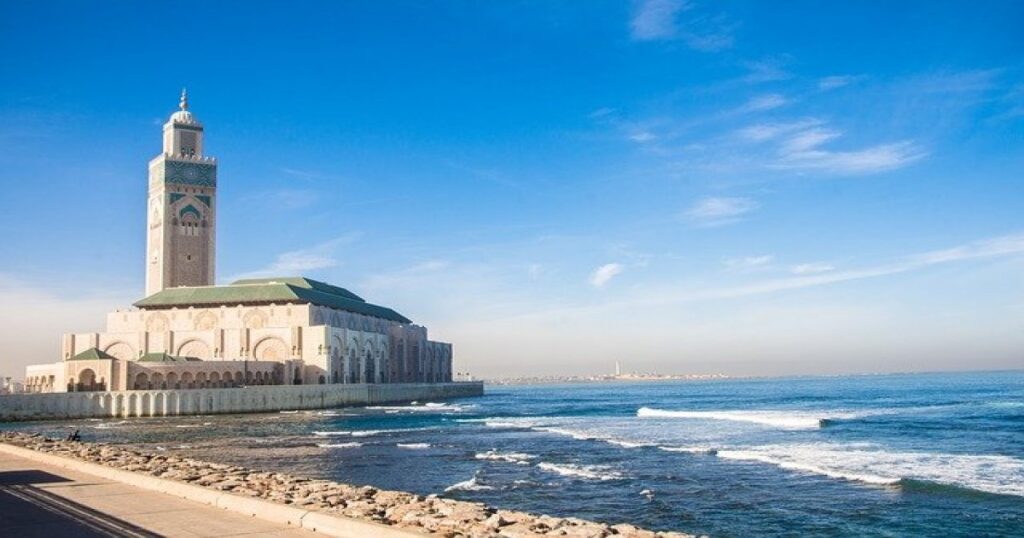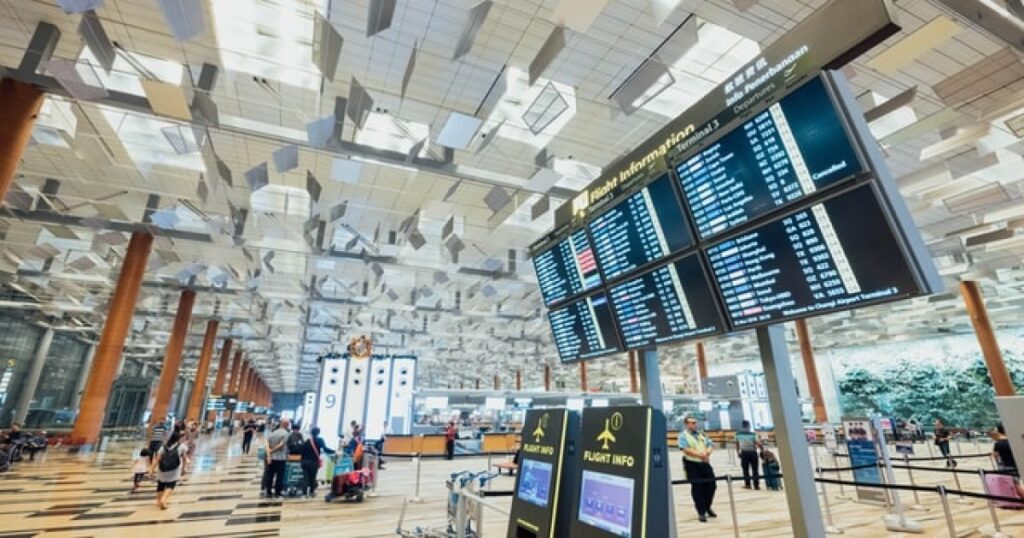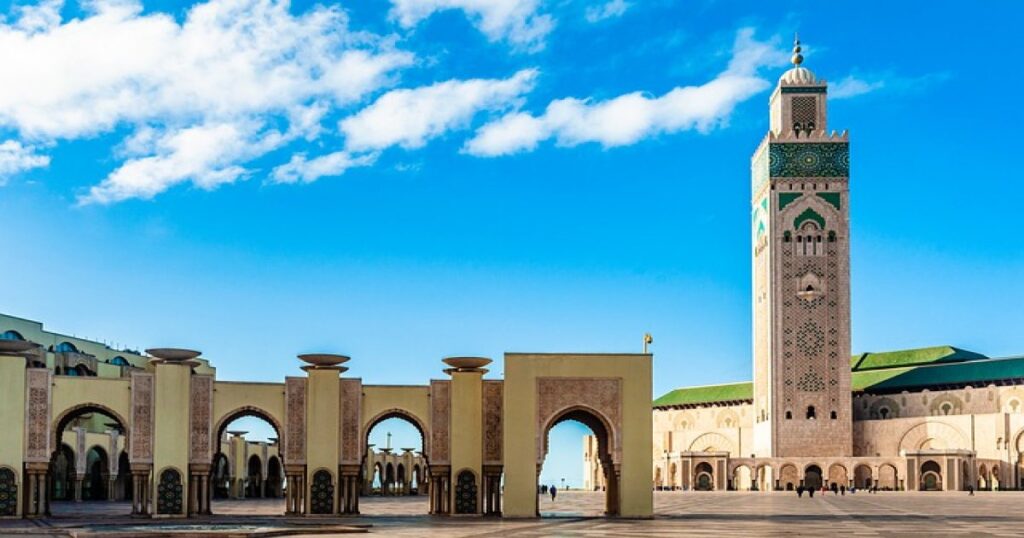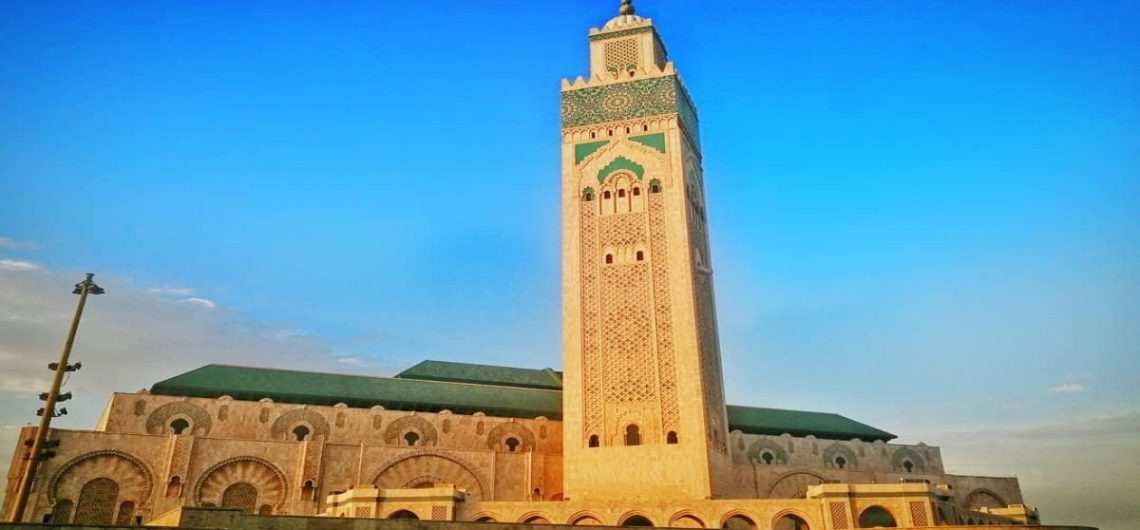Casablanca city, the “white city”, is the largest city in Morocco, a huge port, and actually the second capital of the state. And the largest tourist center on the Atlantic coast of the country: around it there are several popular beach destinations. People come here for the oriental color and interesting shopping, there are mosques, Catholic and Orthodox churches, oriental bazaars and French monuments – everyone will find something interesting.
Top 10 Sights in Casablanca City
Hassan II Mosque
Hassan II Mosque is the main and most beautiful mosque of Casablanca city, located on the very shore of the Atlantic Ocean. It was built in 1993 by the French architect Michel Pinceau and became the largest mosque in the country. Its minaret is 210 meters high and can accommodate up to 25,000 people.
They tried to make this mosque a real national symbol: it is almost entirely built from stone mined in Morocco. This pink marble, onyx, colorful granite, and other rocks. Only the snow-white marble for decorating the columns was brought from Italy. Several thousand Moroccan artists worked on its decoration.
The peculiarity of the building is that it protrudes far into the water. The architect himself said that he was struck by the words of the Koran: “The throne of Allah is upon the water,” and he tried to embody them in the architecture. The view of the ocean opens right out of the prayer hall.

El Hank Lighthouse
The lighthouse at Cape El Hank is one of the symbols of Casablanca city. It was built in 1914. It is a snow-white tower 50 meters high with 256 steps leading to the top. You have to pay to get in, but you can go up if you want.
At the beginning of the XX century, the lighthouse was equipped with the newest and best quality equipment. It worked for 100 years and still does. The light of this lighthouse can be seen from 53 km away. An amusing feature is that on holidays the Moroccans decorate their lighthouse by wrapping it with colorful strips of cloth.
From its top, you have the best view of the coast, the Hassan II mosque, and the fishermen’s quarter with its small, doughty houses. The wide strip of beach in front of the lighthouse is actually a soccer field, much loved by the locals.
Mohammed V Square Ensemble
At the beginning of the twentieth century, when it became clear that there was no more room for public buildings in the Old City, the city was greatly expanded. It was then that the ensemble of this square which is now the administrative center of Casablanca city began to take shape.
The building of the French Consulate, designed by the architect A. Laparde, was erected there in 1916. In 1922, the Palace of Justice – Palais de Justice Mahakma do Paix was built. It was built in the traditional Moroccan style, with rich ornaments and interior decoration, and really looks more like a palace than a simple administrative center. It is now the building that attracts many tourists and inside you can get in with a guided tour or on open-door days several times a year. In 1937, the Prefecture was built with a huge tower – its height is about 50 meters, and this tower is also marked in all travel guides as one of the symbols of the city. Finally, in the center of the square stands the fountain built in 1976, around which huge flocks of pigeons usually fly.
Old Medina of Casablanca
The old medina, the old market of Casablanca city, is an area that has not changed much since the late 19th century. It was lucky – the French leadership decided not to rebuild the old historic center, but simply moved the center of the city to a new location. So now you can quietly walk around the old narrow streets between the buildings, which are 200-300 years old. The quarter remains residential: it is not flushed out for tourists and has not been restored, but it is here you can feel the color of old Morocco.
The market itself is active here: sells everything from fruit to leather goods. It is customary here to haggle – as a rule, no price tags, and you have to negotiate the price with the seller. Be prepared that the initial price is always inflated, and you are expected to try to bring it down. Noisy hustlers, plenty of exotics, the opportunity to see with your own eyes the work of artisans – all this can be found in the old medina.
Museum of the Jewish Community of Morocco
The Jewish community in Morocco is several thousand years old – Jewish traders began to settle here in the IV-III centuries AD. In the Middle Ages, a huge wave of immigrants came here: when the Jews were expelled from Spain and Portugal at the end of the XV century, many moved here with their families. Today, despite the fact that many have moved to Israel, Casablanca has a significant Jewish diaspora. Morocco is now the most Israel-friendly Islamic state, its authorities do a lot to preserve the Jewish heritage: ancient synagogues, cemeteries, etc.
The museum was opened in 1997. The museum has a media center where you can watch films about the history of Moroccan Jews and the exhibition itself is composed of objects of worship and life since the 13th century. Jewish and Arab art have influenced each other for centuries here, and you can see their intertwining in the museum.
Sacred Heart Cathedral
A huge Catholic cathedral was built in the 1930s by the French architect Paul Tournon. This architect was one of the first to use reinforced concrete structures, which made it possible to create truly huge and modern buildings. For example, he owns the famous Church du Saint-Esprit in Paris.
The Cathedral of the Sacred Heart is a grandiose neo-Gothic building with traditional Moroccan motifs. It is often referred to as a “cathedral”, but this is incorrect; there has never been a bishop’s pulpit here, just that this temple is really striking in its scale. Services were held there until 1956, and after the recognition of the independence of Morocco by France, services no longer take place. Now it’s a cultural center with concerts and exhibitions, so it’s free to go inside. The stained glass windows and part of the decor have been preserved.
Abdurahman Slough Museum
A small private museum based on an art collection assembled by the Moroccan businessman Abdourahman Slau. Mainly, it presents antiques of the XIX-XX centuries: a collection of old posters, French art nouveau furniture, household items, engravings, and knickknacks. There are permanent exhibitions, but there are also temporary exhibitions. The museum has a large collection of works by Mohamed Ben Ali R’bati, the most famous Moroccan artist of the 19th and 20th centuries. They are very beautiful and interesting because they combine classic European techniques of painting with traditional Arabic miniature.
The museum occupies two floors and there is a small café on the second floor. Given that Casablanca does not have a traditional local history museum, it is this museum that can replace it.
Habous Quarterly
Habous is a neighborhood built by the French in the 1910s and 1930s during the expansion of the city. This is a must-visit because the real tourist center of Casablanca is here. If the old town can be a little messy and scary in the evenings, it is beautiful, bright, and safe here. The Oriental flavor has been fully preserved here, but it has been preserved by the French-Europeans, so it is just what the tourist needs.
The houses are decorated with Eastern ornaments, beautiful and perfectly clean, the souvenir shops are air-conditioned, and the narrow streets neighbor the wide and green boulevards. There are some beautiful mosques, also built by the French in the thirties, such as that of Sultan Moulay Youssef bin Hassan.
There is also the New Medina, the new marketplace, which is what draws most of the crowds here. The market is divided into sections – somewhere they sell only spices, somewhere – olive oil, somewhere – ceramics, somewhere – sausages from camel meat, but souvenirs – everywhere and at every step. In contrast to the old town, where there are almost no restaurants, here they are abundant.
Notre Dame de Lourdes Cathedral
The current Catholic cathedral was built from 1929 to 1953 by the French architect Auguste Perret. This building is an example of how it is possible not to adhere to the traditional style in religious architecture, but to create something completely new. The temple combines elements of constructivism and neo-gothic. The interior is also very unusual – constructivist columns look interesting against the bright stained glass windows.
The cathedral was built in memory of the apparition of the Virgin Mary in 1858 in the town of Lourdes. Now Lourdes is one of the most important Catholic religious centers. In this cathedral, the statue of Our Lady in the courtyard reminds us of the miraculous apparition. It is in a cave niche, just as it once appeared to a French girl, Bernadette Soubirous.
Tamaris Water Park
15 km from Casablanca city is the largest water park in Morocco, its area is more than 7 hectares. There are several different zones here – children’s (Twistie Paradis), extreme, and family. All three zones are connected by a slow river that flows through the whole area. There is a pool with a real sand beach.
In addition to water activities, there is a bowling alley, and a large children’s play center with a variety of activities, from the driving range to board games. In the afternoon there are usually children’s animators. There is even a mini-zoo with elephants and three cafes with different cuisines: Italian, Moroccan, and American.
All visitors note the cleanliness and order here. European tourists try to get here during the month of Ramadan, when almost only foreigners come here, at other times, especially in the evenings, it can be quite crowded.
Airport in Casablanca
The airport in Casablanca city is named after Sultan Mohammed V. It is located in the city of Nouesser, about 30 kilometers from Casablanca. The airport is connected to many cities around the world and a direct flight Moscow-Casablanca city was launched in 2011.
The airport has 2 terminals which are connected by a passage. Terminal 2 serves international flights and terminal 1 – is domestic.
Annually, more than 7.5 million passengers are served there and the airport has two runways, both 3,720 meters long.
ArticlesArticles about Morocco Articles about Casablanca city.
Casablanca airport Print
Casablanca Airport
The Casablanca Airport is named after Sultan Mohammed V. It is located in the town of Nouesser, around 30 km from Casablanca. The airport is connected to many cities around the world and a direct flight Moscow-Casablanca was launched in 2011.
The airport has 2 terminals which are connected by a passage. Terminal 2 serves international flights and terminal 1 – is domestic.
Annually, more than 7.5 million passengers are served there and the airport has two runways, both 3,720 meters long.

Services
The airport in Casablanca city is ready to offer its guests a variety of services. For business class passengers, the airport has a Business Aviation Lounge with Internet access, office equipment, satellite TV, etc. For conferences, you can use the lounge of the Atlas Airport Hotel, which is located near the terminal.
Casablanca airport also offers a large number of cafes and restaurants that are always ready to feed hungry visitors.
A special service is available for passengers with children – escorting children from four to twelve years of age and ensuring their complete safety. To use this service, you must submit a package of documents in advance.
In addition, the airport has wireless Internet access, post office, ATMs, bank branches, etc.
If necessary, tourists can always use the services of medical assistance in the medical center or buy medicines in the pharmacy.
Recreation
Not far from the airport there is a hotel “Atlas Airport Hotel” – 3 stars, it was mentioned above. Therefore, tourists can always rest comfortably in this hotel. It is worth adding that the airport also has a hotel, but it is only for transit passengers.
How to get there
There are 4 ways to get from the airport to Casablanca city:
- Train. There is a train station in Terminal 1, from which trains depart regularly, at 1-hour intervals. The running time is from 6:50 am to 22:50 pm.
- Bus. Regularly from 5:30 am till 23:00 pm STM buses depart from the airport.
- Cabs. A cab stand is located near the arrivals hall.
- Rent a car. There are several companies in the terminal that provide car rentals.
Walks in Casablanca city

The name of this Moroccan city is well known to all movie lovers, in 1942 an American director shot a romantic film that later became a cult. So today, fans of cinema and romance go for walks in Casablanca, trying to find familiar landscapes and places from the film.
Walks in Casablanca of old
The name of the city is translated very simply – “white house”, but in this simplicity, there is both authenticity and beauty. Walking through the streets of the historic center, the tourist unwittingly notices how much white color surrounds him, in fact, the streets consist of snow-white stone houses and narrow curved streets. The absence of transport is striking, there is nothing but peaceful donkeys, with tourists is the so-called immersion in history, in previous eras, when no one thought of technical progress.
It is this ancient atmosphere that becomes the main attraction of Casablanca city if you travel through it alone, without a guide. If a guide accompanies the traveler or group of tourists, Casablanca city reveals many of its secrets. For example, you can go for a walk through the majestic and imposing building, which has a telling name – Mahakma does Pasha, which sounds like the residence of the Pasha of Casablanca.
The palace complex is built in the Spanish-Moorish style, it is noticeable at a glance. There are about sixty large and small halls, there are cozy inner courtyards, and many of the rooms are decorated with artful carvings typical of this style.
Hassan II Mosque
Another trip to Casablanca may be related to Islamic culture and the local mosques, which are a work of art by ancient and modern architects. The heart of the city is the Hassan II Mosque, which is the second largest (in the world). It was built not so long ago, and that is why Michel Pinceau, a French architect, managed to make the dome slide. Now the place for prayers “with a slight movement of the hand” can turn into an open terrace.
On the one hand, the Hassan II mosque is the main Muslim religious building in Casablanca; on the other hand, other institutions are also housed here:
- a library with a large collection of ancient sacred texts;
- Madrasah, a school for “young theologians;
- The National Museum preserves important artifacts.
In addition, the mosque hosts a variety of cultural events.
Beaches in Casablanca
Casablanca city, an African city with a typical Spanish name, is the largest city in Morocco; it is the business and financial capital of the country. As a seaport, Casablanca has become the largest city in the entire African state. Although the modern capital is Rabat, Casablanca is still considered the symbol of Morocco.
Despite all the connections with other countries of the world, this city on the coast has perfectly preserved its national colors. Small houses, mostly with flat roofs, and towering above them is an imposing mosque, which at certain hours is open to tourists. In principle, a visiting Muslim has the right to enter the religious edifice and pray there not only during “tourist” time.
In this city, those who speak French quite well will feel comfortable, because the local population speaks it to a greater or lesser extent. English-speaking residents are very few. But most visitors to Casablanca city are not primarily focused on excursions, but to indulge in beach vacations.
Many of the beaches in Casablanca are man-made, although they are not inferior to natural beaches. The best sandy beaches in Casablanca city with clear water are:
- Ayn Diab.
- Booznik.
- Agadir.
- Cornish.
The most important beach in Casablanca city is Ain Diab. It is close to the city center. Nevertheless, high waves occur here, which do not always allow a good swim. Therefore, there are numerous swimming pools on the coast and beach clubs nearby. You can swim in the pools with your children.
Bouznika
Buznika is no longer in the city, but between Casablanca and Rabat. The town is also called Buznika, and surfers and swimmers flock here every winter. The beach is 40km away from Casablanca city.
The beach in the city of Agadir, which is located in a closed bay is incredibly popular among tourists. Moreover, it is protected by the surrounding hills. Here is good for water sports – swimming, surfing, water skiing. While in Agadir, it is easy to be deceived: everything looks European, even the clothes of passers-by, while you are in a Muslim country.
The Corniche
The beaches of the Corniche are elite. You will not find a budget holiday here. However, if you are a wealthy person, you can choose this option, as the rest of the beaches of private hotels are organized on the top fork.
Those who love the sun and sultry summers should visit the beaches of Casablanca city, especially if the European and Turkish beaches are already boured.

Comments